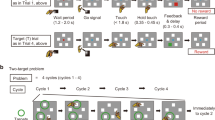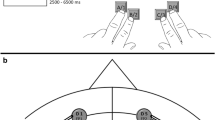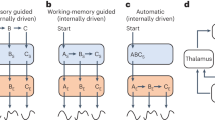Abstract
Anterior cingulate cortex is important in monitoring action for new challenges. We recorded neuron activity in the anterior cingulate sulcus of macaques while they performed a sequential problem-solving task. By trial and error, animals determined the correct sequence for touching three fixed spatial targets. After the sequence was repeated three times, we then changed the correct solution order, requiring a new search. Irrespective of component movements or their kinematics, task-related neurons encoded the serial order of the sequence. Neurons activated with sequence components (68%) differed in activity between search and repetition. Search-related activity occurred when behavioral flexibility was required and ended as soon as the animal accumulated enough information to infer the solution, but had not yet tested it. Repetition-related activity occurred in a regime of memory-based motor performance in which attention to action is less necessary.
This is a preview of subscription content, access via your institution
Access options
Subscribe to this journal
Receive 12 print issues and online access
$209.00 per year
only $17.42 per issue
Buy this article
- Purchase on Springer Link
- Instant access to full article PDF
Prices may be subject to local taxes which are calculated during checkout






Similar content being viewed by others
References
Shallice, T. From Neuropsychology to Mental Structure (Cambridge Univ. Press, 1988).
Wise, S. P., Murray, E. A. & Gerfen, C.R. The frontal–basal ganglia system in primates . Crit. Rev. Neurobiol. 10, 317– 356 (1996).
Passingham, R. E. Attention to action. Phil. Trans. R. Soc. Lond. B Biol. Sci. 351, 1473–1479 (1996).
Paus, T., Petrides, M., Evans, A. & Meyer, E. Role of the anterior cingulate cortex in the control of oculomotor, manual and speech responses: a positron emission tomography study. J. Neurophysiol. 70, 453–468 (1993).
Posner, M. I. & DiGirolamo, G. J. in The Attentive Brain (ed. Parasuraman, R.) 401–423 (MIT Press, Cambridge, Massachusetts, 1998).
Jueptner, M. et al. Anatomy of motor learning. I. Frontal cortex and attention to action. J. Neurophysiol. 77, 1313– 1324 (1997).
Carter, S.C et al. Anterior cingulate cortex, error detection, and the online monitoring of performance. Science 280, 747–749 (1998).
Picard, N. & Strick, P.L. Motor areas of the medial wall: a review of their location and functional activation. Cereb. Cortex 6, 342–353 ( 1996).
Devinsky, O., Morrell, M. J. & Vogt, B.A. Contributions of anterior cingulate cortex to behavior . Brain 118, 279–306 (1995).
Zilles, K. et al. Mapping of human and macaque sensorimotor areas by integrating architectonic, transmitter receptor, MRI and PET data. J. Anat. 187, 515–537 ( 1995).
Shima, K. et al. Two movement-related foci in the primate cingulate cortex observed in signal-triggered and self-paced forelimb movements. J. Neurophysiol. 65, 188–202 ( 1991).
Shima, K. & Tanji, J. Role for cingulate motor area cells in voluntary movement selection based on reward. Science 282, 1335–1338 (1998).
Procyk, E. & Joseph, J.P. Problem solving and logical reasoning in the macaque monkey. Behav. Brain Res. 82, 67–78 (1996).
Dum, R.P. & Strick, P. L. The origin of corticospinal projections from the premotor areas in the frontal lobe. J. Neurosci. 11, 667–689 (1991).
Mattelli, M., Luppino, G. & Rizzolatti, G. Architecture of superior and mesial area 6 and the adjacent cingulate cortex in the macaque monkey. J. Comp. Neurol. 311, 445–462 (1991).
Gabbot, P. L. & Bacon, S.J. Local circuit neurons in the medial prefrontal cortex (areas 24a,b,c, 25 and 32) in the monkey: I. Cell morphology and morphometrics. J. Comp. Neurol. 364, 567–608 (1996).
Carpenter, A.F., Georgopoulos, A.P. & Pellizzer, G. Motor cortical encoding of serial order in a context–recall task. Science 283, 1752– 1757 (1999).
Barone, P. & Joseph, J.P. Prefrontal cortex and spatial sequencing in macaque monkey. Exp. Brain Res. 78, 447 –464 (1989).
Kermadi, I. & Joseph, J.P. Activity in the caudate nucleus of monkey during spatial sequencing. J. Neurophysiol. 74, 911–933 (1995).
Tanji, J. & Shima, K. Role for supplementary motor area cells in planning several movements ahead. Nature 371 , 413–416 (1994).
Clower, W. T. & Alexander, G.E. Movement sequence-related activity reflecting numerical order of components in supplementary and presupplementary motor areas. J. Neurophysiol. 80, 1562– 1566 (1998).
Shidara, M., Aigner, T. G. & Richmond, B.J. Neuronal signals in the monkey ventral striatum related to progress through a predictable series of trials. J. Neurosci. 18, 2613–2625 ( 1998).
Schultz, W., Tremblay, L., Hollerman, J. R. & Mirenowicz, J. in The Association cortex. Structure and Function (eds. Sakata, H., Mikami, A. & Fuster, J. M.) 67–84 (Harwood, Amsterdam, 1997).
Nakamura, K., Sakai, K. & Hikosaka, O. Neuronal activity in medial frontal cortex during learning of sequential procedures. J. Neurophysiol. 80, 2671–2687 (1998).
Shima, K., Mushiake, H., Saito, N. & Tanji, J. Role for cells in the presupplementary motor area in updating motor plans. Proc. Natl. Acad. Sci. USA 93, 8694–8698 (1996).
Miller, G. A., Galanter, E. & Pribram, K.H. Plans and the Structure of Behavior (eds. Miller, G. A., Galanter, E. & Pribram, K. H.) 159–175 (Adams-Bannister-Cox, New York, 1986).
Hanes, D. P., Thompson, K. G. & Schall, J.D. Relationship of presaccadic activity in frontal eye field and supplementary eye field to saccade initiation in macaque: Poisson spike train analysis. Exp. Brain. Res. 103, 85–96 (1995).
Acknowledgements
We thank S. Castner, W. Clower, J. Bullier, M. Jeannerod, K. Knoblauch and L. Romanski for their comments and V. Auger, C. Baleydier, V. Gaveau, M.L. Loyalle, P. Monjaud and C. Urquizar for technical assistance. This work was supported by GIS sciences de la cognition, France.
Author information
Authors and Affiliations
Corresponding author
Rights and permissions
About this article
Cite this article
Procyk, E., Tanaka, Y. & Joseph, J. Anterior cingulate activity during routine and non-routine sequential behaviors in macaques. Nat Neurosci 3, 502–508 (2000). https://doi.org/10.1038/74880
Received:
Accepted:
Issue Date:
DOI: https://doi.org/10.1038/74880
This article is cited by
-
Learning how network structure shapes decision-making for bio-inspired computing
Nature Communications (2023)
-
Foraging with the frontal cortex: A cross-species evaluation of reward-guided behavior
Neuropsychopharmacology (2022)
-
Formalizing planning and information search in naturalistic decision-making
Nature Neuroscience (2021)
-
Chimpanzee histology and functional brain imaging show that the paracingulate sulcus is not human-specific
Communications Biology (2021)
-
The macaque anterior cingulate cortex translates counterfactual choice value into actual behavioral change
Nature Neuroscience (2019)



